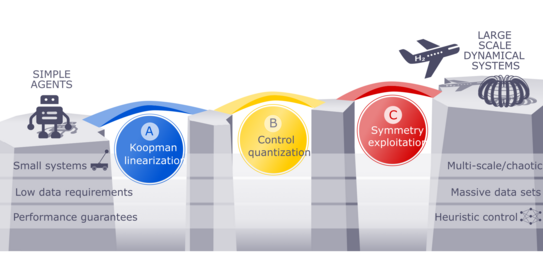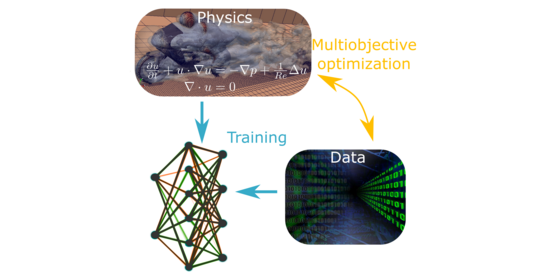Research topics
In this area, we focus on understanding, predicting, and controlling systems that evolve over time by leveraging data rather than relying solely on traditional physics-based models. Dynamical systems are prevalent in many fields, from engineering and robotics to biology, economics, and climate science. These systems are typically described by mathematical models like differential equations or discrete-time equations.
In this context, data-driven approaches use measurements collected from the system—such as sensor data or experimental observations—to build models that describe its behavior. This is particularly useful when first-principles models (derived from physical laws) are too complex, incomplete, or unavailable. Machine learning methods, system identification techniques, and tools like Koopman operator theory play a central role in extracting patterns from data to construct these models.
Once a model is established, it can be used for control purposes—to influence the system’s behavior toward desired outcomes. Data-driven control strategies include reinforcement learning for decision-making or model predictive control (MPC), where predictions based on learned models guide actions in real time.
This field has wide-ranging applications: optimizing energy systems like power grids; enabling autonomous robots to adapt to changing environments; improving industrial processes; or even managing ecosystems and biological networks. However, challenges such as dealing with noisy or incomplete data, ensuring robustness of learned models, and balancing interpretability with accuracy remain active areas of research.
Ultimately, this field represents an exciting intersection of mathematics, machine learning, and engineering aimed at harnessing the power of data to better understand and manage complex dynamic processes.
Multi-objective optimization focuses on solving problems where there are multiple, often conflicting objectives to consider. Unlike single-objective optimization, where the goal is to optimize a specific criterion, multi-objective optimization involves balancing trade-offs between different goals. For example, in engineering design, one might aim to minimize cost while maximizing performance, or in logistics, reduce delivery time while lowering fuel consumption.
A key concept in this area is Pareto optimality. Since it’s usually impossible to optimize all objectives simultaneously, the focus shifts toward finding solutions where no objective can be improved without worsening at least one other. These solutions form what’s known as the Pareto front—a set of trade-off points that represent the best possible compromises.
This type of optimization has applications across many fields. In finance, it helps balance risk and return; in environmental science, it addresses trade-offs between economic growth and pollution reduction; and in manufacturing or robotics, it supports decisions involving efficiency versus quality or safety. One specialty in our group is the application in machine learning, which results in the area of multi-objective machine learning.
The main challenge lies in managing these trade-offs effectively—especially when dealing with high-dimensional problems such as the training of deep learning problems. Yet multi-objective optimization remains essential for tackling real-world problems that involve complex decision-making under competing demands.
Ongoing research projects
Koopman-Operator-based Reinforcement Learning Control of Partial Differential Equations
Funded by the European Research Council. More information under https://doi.org/10.3030/101161457.
Improving the energy-intensive and computationally heavy analysis of big data is a driving goal in many fields from basic research on the origins of the universe to predicting climate change or controlling large-scale dynamical systems in safety-critical engineering applications. Reinforcement learning (RL) is a promising technique to reduce the energy requirements of the last. However, linear or kernel methods do not scale well, minimising their utility to practical applications. They are also computationally intensive and thus energy hungry. The ERC-funded KoOpeRaDE project aims to leverage control theory, approximation theory and machine learning to reduce complexity and support development of innovative RL controllers for large-scale engineering systems with performance guarantees.
Collaboration with Jörg Schumacher & Dmitry Krasnov (TU Ilmenau). Funded by the DFG.
Nuclear fusion is one of the most promising, but also most demanding technical concepts to address the ever-growing demand of clean electrical energy. To realize such a system, a large number of significant challenges needs to be tackled, one of them being the development of techniques for efficiently transporting heat from the fusion reactor to consecutive process steps (e.g., steam turbines). A very promising approach for this is actively controlling the flow of liquid metals within cooling blankets. In this technology, there are still large knowledge gaps, both in terms of the flow physics and efficient control strategies. The overarching goal of this project is thus the advancement of numerical simulation and surrogate-based control techniques for highly complex liquid metal flows in the presence of strong magnetic fields. Thereby, we will make significant advances in the understanding of the underlying physics as well as regarding the development of control schemes for Tokamak-type nuclear fusion reactors. To achieve the envisioned goals, we will perform basic research in the numerical modeling of MHD flows subject to strong magnetic fields and conducting walls, and in addition with control inputs, e.g., in the form of inflow velocity profiles. This will allow us to conduct detailed direct numerical simulation (DNS) studies. The central aim is to identify quasi-two-dimensional structures as well as to study their stability properties and how they react to external forcings. As a next step, we will use this simulation data and the gained physical knowledge to train highly efficient surrogate models with inputs in order to be able to tackle multi-query problems such as parameter studies or optimal control problems. The key components of these surrogate models will be based on the Koopman operator framework, which allows us to identify linear dynamics in function spaces from time series data. Finally, these surrogate models will be used to identify efficient feedback laws. In this context both model predictive control and model-based reinforcement learning approaches will be investigated. Achieving these goals for a realistic configuration requires interdisciplinary research with experts from fluid dynamics, machine learning, as well as their combination, and the team of applicants from TU Dortmund and TU Ilmenau represents exactly these areas of expertise.
Funded by the Federal Ministry of Education and Research (BMBF).
In virtually all areas of technology, business, and society, multiple competing criteria are of equal or similarly high importance. For example, it is desirable for electric vehicles to be both fast and have a long range, for a manufactured product to exhibit high quality while maintaining low production costs, or for political decisions to consider economic, ecological, and social aspects simultaneously. In all these examples, the challenge lies in identifying and selecting optimal compromise solutions (so-called Pareto optima). Similarly, in machine learning, it is natural to formulate a variety of criteria that should all be fulfilled as well as possible. These include not only the obvious minimization of training error but also achieving the best possible generalization beyond the training data, robustness against disturbances, numerical efficiency, and optimal interpretability.
In contrast to many fields of technology and society—where considering multiple criteria simultaneously is standard practice (e.g., in cancer treatment)—the enormous potential of multi-objective optimization in machine learning remains largely untapped. The central research focus of this project is therefore the development of multi-objective optimization methods that make the training of deep neural networks more robust, efficient, and interactive. Furthermore, especially in technical applications, there often exists extensive system knowledge. This leads to another key point: integrating such knowledge into optimization procedures at varying levels directly. To significantly improve supervised learning methods, these aspects require an interdisciplinary research approach spanning optimization techniques, machine learning methodologies, and data-driven engineering sciences.
Collaboration with Walter Sextro (Paderborn University). Funded by the DFG within the Priority Program 2353 "Daring More Intelligence". More information under the following Link.
There is hardly ever a situation where only one goal is of interest at a time. When carrying out a purchase, for example, we want to pay a low price for a high quality product. In the same manner, multiple objectives are present in the design of essentially all technical systems such as fast and energy efficient electric vehicles, light yet stable constructions, or more generally the simultaneous achievement of technical, economic and ecological objectives. This dilemma leads to the field of multiobjective optimization, where the aim is to optimize all relevant criteria simultaneously. While one optimal solution is usually sufficient in the single-objective setting, there exists an infinite number of optimal compromises in the presence of multiple, contradictory objectives. Knowledge of the associated Pareto set allows for the well-informed selection of trade-off solutions and for the flexible adaptation of designs to changing prioritization or external influence factors. Conflicting criteria also occur in the design of complex multibody systems such as vehicle suspension systems, where the minimization of production costs and tire wear as well as the maximization of driving comfort and safety are highly desirable. The complexity of such multibody dynamics has been constantly increasing over the past years, the key enabler being the rapidly growing computational capabilities which allow for the simulation of increasingly detailed, large scale models. Despite the available computing resources, the multicriteria design of systems with such a high degree of complexity is still beyond today's computing powers.To address these challenges, the central goal of this research project is the development of a highly flexible and adaptive data-enhanced framework for the multicriteria design of complex multibody systems. The central components are the online collection of data from various sources, the data-driven and hybrid modeling (i.e., using equations and data at the same time) of individual components with varying degrees of accuracy, and the interactive multiobjective optimization of the resulting hybrid model. The intention behind the hybrid modeling is to exploit the best of both worlds, i.e., to use equations governing the physics where possible, and on the other hand to further enhance the performance and accuracy using data-driven models whenever the physics-based models are inaccurate, too expensive to evaluate, or even unknown.The developed methodology will be highly useful in the design of a large number of multibody systems, and will thus be of great use to other projects within the Priority Programme while at the same time contributing to the overall program goals.
Collaboration with Software Innovation Campus Paderborn, Fraunhofer IZM, University of Passau, WestfalenWIND IT GmbH & Co KG, AixpertSoft GmbH. Funded by the Federal Ministry of Education and Research (BMBF).
The project develops an infrastructure for HPC (High-Performance Computing) distributed across wind turbines (WTs). It investigates sustainable energy and thermal management operations within a wind farm. The locally limited, directly generated usable energy budget determines the maximum power consumption of the HPC systems over a fixed period. As an additional sustainable innovation and control parameter, the use of the structural capability to transfer heat to a heat sink—the inner tower surface of the WT—is planned. This optimization increases the usable share of the energy budget (PUE) in favor of IT systems, and direct energy supply reduces CO2 emissions (not just on paper). Resolving various goal conflicts within the project represents the scientific challenge and consists of:
(a) maximizing direct and low-loss energy supply,
(b) minimizing downtime due to curtailment and supply with residual power,
(c) ensuring safe cooling of computing technology,
(d) exploring the potential for dynamically activating HPC systems for their applications under volatile power supply conditions, and
(e) maximizing utilization of existing infrastructure.
Funded by the State of Northrhine-Westfalia. More info under https://www.sail.nrw/.
SAIL is an interdisciplinary and interinstitutional collaboration of Bielefeld University, Paderborn University, Hochschule Bielefeld – University of Applied Sciences and Arts (HSBI) and OWL University of Applied Sciences and Arts (TH OWL), funded by the MKW NRW.
Current systems that incorporate AI technology mainly target the introduction phase, where a core component is training and adaptation of AI models based on given example data. SAIL’s focus on the full life-cycle moves the current emphasis towards sustainable long-term development in real life. The joint project SAIL addresses both basic research in the field of AI, its implications from the perspective of the humanities and social sciences, and concrete applications in the field of Industry 4.0 and Intelligent Healthcare.
Past projects
-
“digiFellows” digital teaching project: Modularisierbare Flipped-Classroom Kurskonzepte füur heterogene Lernendengruppen anhand des Beispiels “Data Science for Complex SystemEngineering” (MOFA)
-
Trainings-, Validierungs- und Benchmarkwerkzeuge zur Entwicklung datengetriebener Betriebs- und Regelungsverfahren für intelligente, lokale Energiesysteme (DARE)
- DFG Priority Program 1926: Project "Multiobjective Optimization of Non-Smooth PDE-Constrained Problems — Switches, State Constraints and Model Order Reduction" (Link)
- "Simultaneous development and testing of Cyber Physical Systems using the example of autonomous electric vehicles" (SET CPS)




